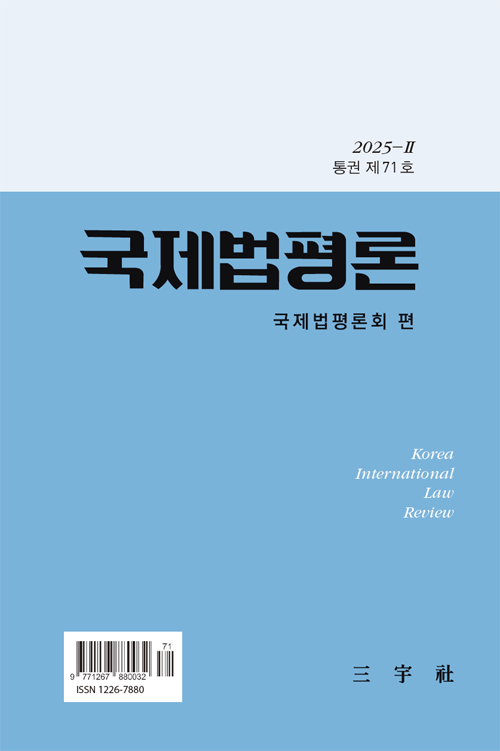- 영문명
- The Protection of Submarine Cables and the International Law of the Sea
- 발행기관
- 국제법평론회
- 저자명
- 이기범(Ki Beom Lee)
- 간행물 정보
- 『국제법평론』제71호, 1~31쪽, 전체 31쪽
- 주제분류
- 법학 > 법학
- 파일형태
- 발행일자
- 2025.06.30
6,520원
구매일시로부터 72시간 이내에 다운로드 가능합니다.
이 학술논문 정보는 (주)교보문고와 각 발행기관 사이에 저작물 이용 계약이 체결된 것으로, 교보문고를 통해 제공되고 있습니다.

국문 초록
The protection of submarine cables is an important issue for both the ‘economy’ and ‘security’ of any coastal State. However, it seems that the international law of the sea does not completely regulate the matter. As can be seen from the Eagle S incident which occurred on 25 December 2024, whether a coastal State can have and exercise enforcement jurisdiction over a foreign vessel in its ‘exclusive economic zone’, if the foreign vessel is involved in the breaking or injury of submarine cables laid by the coastal State, is the biggest issue currently facing the international law of the sea.
Under the 1884 Paris Convention, the 1958 High Seas Convention and the 1982 UNCLOS, a just ‘legislative’ ‘obligation’ to define the breaking or injury of submarine cables as a ‘punishable offence’ has only been imposed on States Parties. Furthermore, the scope of applying such legislation is limited to a ship flying the flag of the coastal State or to a person subject to jurisdiction of the State. With this legal background, various ideas are being proposed for the coastal State in order to have and exercise enforcement jurisdiction. For example, (i) the logic of considering the breaking or injury of submarine cables as ‘piracy’, (ii) the logic of utilizing Article 60, Paragraph 4 of the UNCLOS, and (iii) State practice comprehensively utilizing Articles 56, 58 and 60 of the UNCLOS.
Among the three proposals, the logic utilizing Article 60, Paragraph 4 of the UNCLOS is particularly notable. It is basically an attempt to establish a ‘safety zone’ for the protection of submarine cables, and then to exercise enforcement jurisdiction in combination with the concept of the ‘right of hot pursuit’ if a foreign vessel is involved in the breaking or injury of submarine cables within the safety zone. This attempt may raise the question of whether submarine cables can be included in the ‘installations’ or ‘structures’ mentioned in Article 60, Paragraph 4 of the UNCLOS. With respect to the question, it seems possible to give a positive answer as long as the submarine cables in question have ‘economic purposes’. Under the current regime of the UNCLOS, the logic of utilizing Article 60, Paragraph 4 of the UNCLOS may be the most logical position to increase the possibility that a coastal State can have and exercise enforcement jurisdiction over a foreign vessel in its exclusive economic zone for the protection of submarine cables.
영문 초록
목차
Ⅰ. 서 론
Ⅱ. 해저 케이블의 보호에 관한 국제해양법적 체제의 발전 및 현재: 1884년 해저전신케이블 보호협약부터 1982년 UN해양법협약까지
Ⅲ. 해저 케이블의 보호를 위한 국제해양법의 활용
Ⅳ. 결 론
해당간행물 수록 논문
참고문헌
관련논문
법학 > 법학분야 BEST
- 인공지능 판사, 과연 가능한가?
- 정치의 사법화와 사법의 정치화 : 온건하고 실용적인 헌법재판의 당위성
- 자국 우선주의 정책과 국제법상 난민⋅이민자 보호-트럼프 행정부의 미국 우선주의를 중심으로-
법학 > 법학분야 NEW
- [스페인]검찰의 구형보다 중한 형을 선고한 판결에 대한 재판소원–헌법소원의 적법요건으로서 ‘특별한 헌법적 중요성’
- [미국]차별사건에서 다수집단에 속하는 청구인에게 추가적인 입증책임이 부과되는지 여부
- [독일]독일 내 미군기지에 예멘 공격 드론을 배치한 것이 예멘인에 대한 독일의 기본권보호의무를 위반한 것인지 여부
최근 이용한 논문
교보eBook 첫 방문을 환영 합니다!

신규가입 혜택 지급이 완료 되었습니다.
바로 사용 가능한 교보e캐시 1,000원 (유효기간 7일)
지금 바로 교보eBook의 다양한 콘텐츠를 이용해 보세요!



